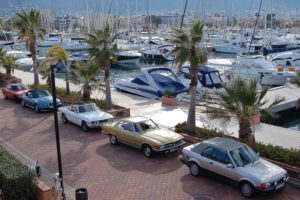
Parking



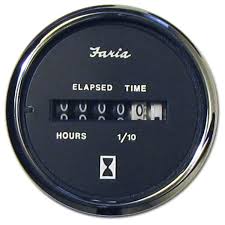 I feel the importance of engine hours are over emphasized by the majority of boat buyers. My opinion doesn’t change the fact that engine hours are considered important by boat buyers. A boat deal fell apart due to a question about engine hours and was the motivation for this article.
I feel the importance of engine hours are over emphasized by the majority of boat buyers. My opinion doesn’t change the fact that engine hours are considered important by boat buyers. A boat deal fell apart due to a question about engine hours and was the motivation for this article.
The potential buyer rejected the vessel with his primary concern being the reported verses actual engine hours. The current owner had replaced the tachometers, equipped with digital hour meters, when one failed. The hours on the original hour meters were reported at 850, the new hour meters registered 300.
When this condition was discovered we explained our opinion regarding engine hours and hour meters.
The only certain information provided by an engine hour meter are the hours displayed by the hour meter, not necessarily the actual engine hours. There is no legal requirement for engine hour meters on boats. They are not odometers on automobiles or Hobbs meters on planes, both of which are regulated. The only way to know that an hour meter is accurate is to have had a relationship with that meter from the beginning, logging hours and comparing those to the hour meter or otherwise monitoring its accuracy continuously through the life of the vessel. Computerized engines provide operating hours with greater dependability, but the electronic control modules (computers) can be changed, just like analog hour meters.
We emphasize engine condition verses operating hours. Many engines with far more operating hours are in much better condition than lesser used engines which have been neglected.
Regardless, the boat buying public cares about engine hours. As a boat owner, and eventually a boat seller, maintain the hour meters so the operating hours can be accurately recorded and provided to potential buyers.
As to how long engines last, that is a different subject and is addressed in a prior article which can be found at https://themarinesurveyors.com/how-long-will-my-engine-last/
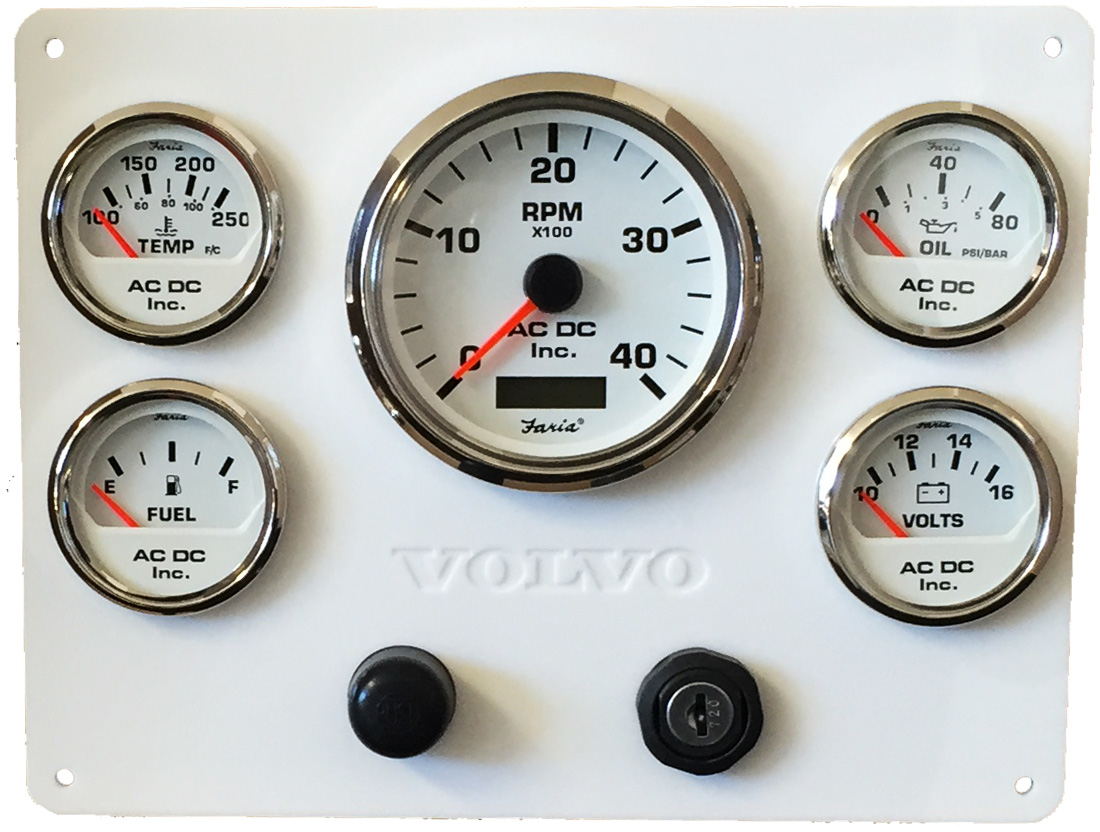
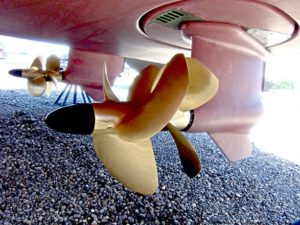
Autopilots have been around forever, but autonomous vessel operation is currently being developed using technological advancements, and some of the same systems used for self driving cars. Self driving boats are much easier most of the time; the ocean is big and has less traffic.
I recently drove a car with some autonomous features and while it added a component of safety, like mandating a safe distance between my car and the next car forward, I also noticed how easy it was to rely on that feature and let my guard down.
There are large scale self driving projects underway. Japan, Norway and Holland have autonomous vessel testing underway. The recent series of ship vs. ship accidents have been mostly attributed to human errors and many feel the outdated control technology can be improved upon. There is a company selling sailing drones for ocean research (saildrone.com). These vessels are controlled from remote control rooms and by computer programs (think Olympic drones.)
On several occasions the undersigned has surveyed a multihull sailboat that was converted to a fixed wing sailing drone for the military and later sold to the private sector. One of our jobs arose from this high powered vessel damaging its dock when the computers were removed for service and a large wind created extreme forces and ripped the dock loose. Usually the computers would orient the fixed wing sails to prevent such a problem.
In the recreational vessel realm, there are pod drives and conventionally powered vessels with “drive by wire” controls. For those unfamiliar with pods, both Volvo and Cummins offer drive systems that don’t include a rudder and all controls are electronic, no mechanical linkage and no hydraulics. The pods are transmissions protruding from the bottom of the boat which spin and thrust independently at the direction of the computer. The operator simply tells the boat where to go with either a joystick or “faux” conventional controls (steering wheel and levers) and the drive system computer decides what the pods need to do to make the boat go there.
We can all parallel park one of these boats.
This same control concept is in use on other drive systems, including inboard and outboard engines. The evolution of electronic control systems facilitates automation. I have spun boats in circles while moving in a straight line down the bay. There are dynamic positioning systems that can keep the boat in one location without an anchor. A now common test during seatrials is to push a button and watch the boat’s computer control the propulsion gear to counter the wind and current; the boat remains in one location and orientation.
And our claim files are full of problems with electronic controls, though far less now than in the early days of these systems. Still, we must keep a look out and be ready to take action to avoid a collision and not let our guard down.
Japan https://worldmaritimenews.com/archives/228202/nyk-to-test-autonomous-boxship-in-2019/
Norway https://worldmaritimenews.com/archives/237297/norway-opens-new-test-area-for-autonomous-ships/
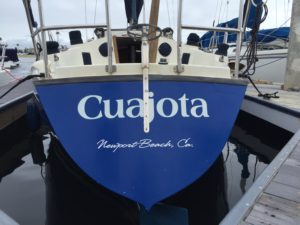
There are two ways to prove ownership of a US flagged vessel, Coast Guard documentation and state registration. All vessels over 5 net tons are eligible for Coast Guard documentation and the form of ownership record or title is an owner’s choice. Lenders generally insist on vessels being documented so they may be the subject of a Preferred Ship Mortgage.
Registered vessels must display the registration number and a current registration decal on both sides of the bow, while documented vessels must display the name and the hailing port on the transom or on both hull sides.
Naming a vessel can be a difficult decision, often reflecting a family member’s name or referencing the business of the owner in some clever way. Less thought is put into the hailing port, but the hailing port is a choice. It does not have to be the place where the boat is stored, where you live nor does it have to have any actual significance or relevance to your life. What do you think are the parameters for choosing a valid hailing port?
Recently I have seen hailing ports including Huntington Harbor, Mission Bay and Surf City. To my surprise Huntington Harbor and Mission Bay were both the hailing ports actually on the document. The owner of the vessel with hailing port Surf City liked Huntington Beach’s “official” nickname, but he was not in compliance with federal regulations as the hailing port on the document did not match the hailing port on the transom. As a result of these unusual haling ports, we researched the rules for hailing ports.
Throughout my career it had been my understanding that the hailing port had to be an actual city in the United States or a US territory. Some had told me that a hailing port had to have a post office, but I had never researched the actual rule, and I wondered what made a location a “city”?
My thanks (and a belated Happy Birthday) to Bernadine Trusso of Dona Jenkins Maritime Document Service, Inc. Bernadine discussed this issue with an officer in the Coast Guard and they confirmed that the website used by documentation personnel is https://geonames.usgs.gov/apex/f?p=138:1:0:::::
To determine if a location is a valid hailing port, click the “Query” tab, fill in the “feature name” and the “state” and then hit the “Send Query” tab. If the feature name comes up as written, such as Point Loma, the location is a valid hailing port. In the case of Point Loma the class is cape. In the case of Mission Bay the class is bay and in the case of Leucadia the class is populated place. The class of the location is irrelevant according to our source, as long as the feature name comes up as you have searched it, without additional words.
The name and the hailing port must be displayed externally on the vessel, either on both sides of the hull or on the transom. The hailing port must include the place and a state, territory, or possession of the United States. The state may be abbreviated.
We often find hailing ports without the necessary state, territory or possession included. We often find names and hailing ports from prior documents, legally requiring modifications to the current documented name and hailing port. We occasionally find registration numbers on documented boats (a no no), documentation numbers on the exterior of boats (unnecessary) or no identifying numbers, name or hailing port (begging to be boarded by the authorities).
Registered boats may have names and hailing ports, but these boat names are decoration, an expression of individuality, and can be changed at any time as they are not legally significant. Based on my newly found resources, Huntington Harbor and Mission Bay are in fact valid hailing ports, but not Surf City and now you have the ability to be as creative with your hailing port as with your vessel’s name.
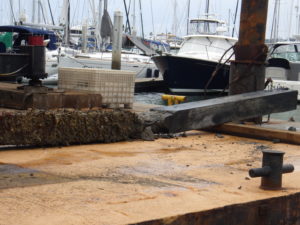
The basic idea of a neutral safety switch is to prevent starting a boat’s engine when its transmission is “in gear”. This prevents the boat from moving suddenly and unexpectedly when an engine is started and is a good safety feature. An unexpected sudden movement of a boat can be catastrophic.
Recently a 90’ motor vessel’s engine started in gear and damaged the dock to which it was secured. Fortunately there were no injuries. There were several contributing causes, including a new operator unfamiliar with the systems and either no neutral safety switch or one that didn’t work.
I polled a few mechanics and inquired if they test the neutral safety switch function during mechanical surveys. Most do not.
The mechanics all mentioned that many boats don’t have these devices. One mechanic/surveyor said that most sailboats don’t have them. A Detroit Diesel specialist said that Jimmy’s usually don’t have them, but I was on a 118’ Hatteras at the moment that did have them on all three 12V92’s. Most small boats with outboards, outdrives and gasoline inboards have a neutral safety switch in the engine control handle. Some transmissions have the switch mounted on the shift lever. Hydraulic and pneumatic controls (like the one in the 90’ MY) can have them, but many do not. Most new electronically controlled engines do have them as part of the control system.
What this means to us as boaters is we can not assume our boat has a neutral safety switch and we should know so we can take proper actions to prevent an accident. There is a way to safely test the neutral safety switch. The basic idea is to find the switch’s wires, check for continuity in neutral and make sure continuity is broken when the transmission control is not in neutral. For those interested in a bit more technical specifics see the following from Ricky at Advanced Marine Power:
“Safely checking the switch would entail using a voltmeter/multimeter with the ability to read resistance/ohms. Place the two leads of the meter on each wire/terminal of the neural safety switch. Set the meter to read ohms; this will check for electrical continuity. Turn the ignition key on, but do not start the engine. There should be a resistance value on the meter, signifying that the electrical circuit has continuity. With the key still on, engine not running, shift the transmission into forward. Check the meter. There now should be no resistance value, or “OL”. This signifies that the electrical circuit does not have continuity, and thus will not allow the engine to start. Repeat the process by shifting into reverse.”
Then there is the layman’s method, put the transmission control in gear and try to start the engine. If you are ready for it, you should be able to control throttle and dock lines so that if it does start, you don’t hurt anything. You can also just bump the starter, versus starting the engine.
Either method will give you crucial information as to the function of your engine starting system and reduce the potential for surprises, boat or dock damage or worse.
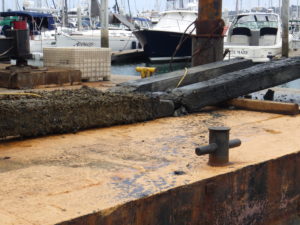
The recreational marine industry is a small subset of larger industries. We are a small part of manufacturing, banking, insurance, and yes the gig economy. As with most of these industries, the boating industry’s slice of the pie is small, but to those involved it is significant. Some of us love the progress and convenience that comes along with these new ideas and apps, some are firmly against these new types of business arrangements and many just don’t want it in their marina.
The boat based temporary rental market mirrors land based Airbnb and VRBO markets. Both continue to pose challenges to governments, frustrate neighbors and provide opportunities and access to many. As it is on land, some are firmly against renting a boat as a place to sleep while many are reaping the financial rewards of just such usage. And as it goes on land, there are questions of legality, interpretations of regulations vary depending on which expert you ask, and the relative ease of finding short term rentals online. The most common interpretation of a legal “boatel” requires the boat to be unable to operate away from the dock, but it takes very little searching to find other opinions.
Short term boat rentals are not just for sleeping and remaining in the slip. One app, Getmyboat.com, lets you rent a wide selection of boats for short periods of time, and use them as boats, underway. This is the closest app that I have found to Uber, Lyft or Turo on the water. You can even get an insurance policy for the few hours of your rental.
Of course there are “legitimate” short term boat rentals, including Boat and Breakfasts, boat rentals, yacht charters and passenger vessels, available for the less daring or technically sophisticated. These companies provide instruction, support, varieties of boats and convenience, albeit at a higher price. All are gateways to enjoying the water onboard and all contribute to the recreational marine economy.
Social media, including Facebook, YouTube, Instagram, Snapchat and Twitter, is also aboard. I work with boat brokers who are prolific video posters. There are tonnes (maritime allusion) of boating blogs. The information available online regarding “how to” do something on a boat is readily available. Like land based topics, our challenge is to sort through the BS and find the expert advice. The sorting often takes longer than replacing the water pump’s impeller, once the right video is found.
Next up, following the theme of technological advancement: self-driving boats.
This sea story originates from an insurance claim we were involved with and comes with a lesson.
The story beings with the purchase of a five year old 45’ motor vessel equipped with two diesel engines. The buyer had a marine survey and a mechanical survey at the time of purchase. She bought the vessel and hired a captain to train her in its operation.
Fifteen minutes into her fourth training session there was a change in the color of the engine exhaust smoke and subsequently they find the cabin thick with smoke.
A fire had started in the engine room. The fire was extinguished by a fixed, automatic fire extinguisher.
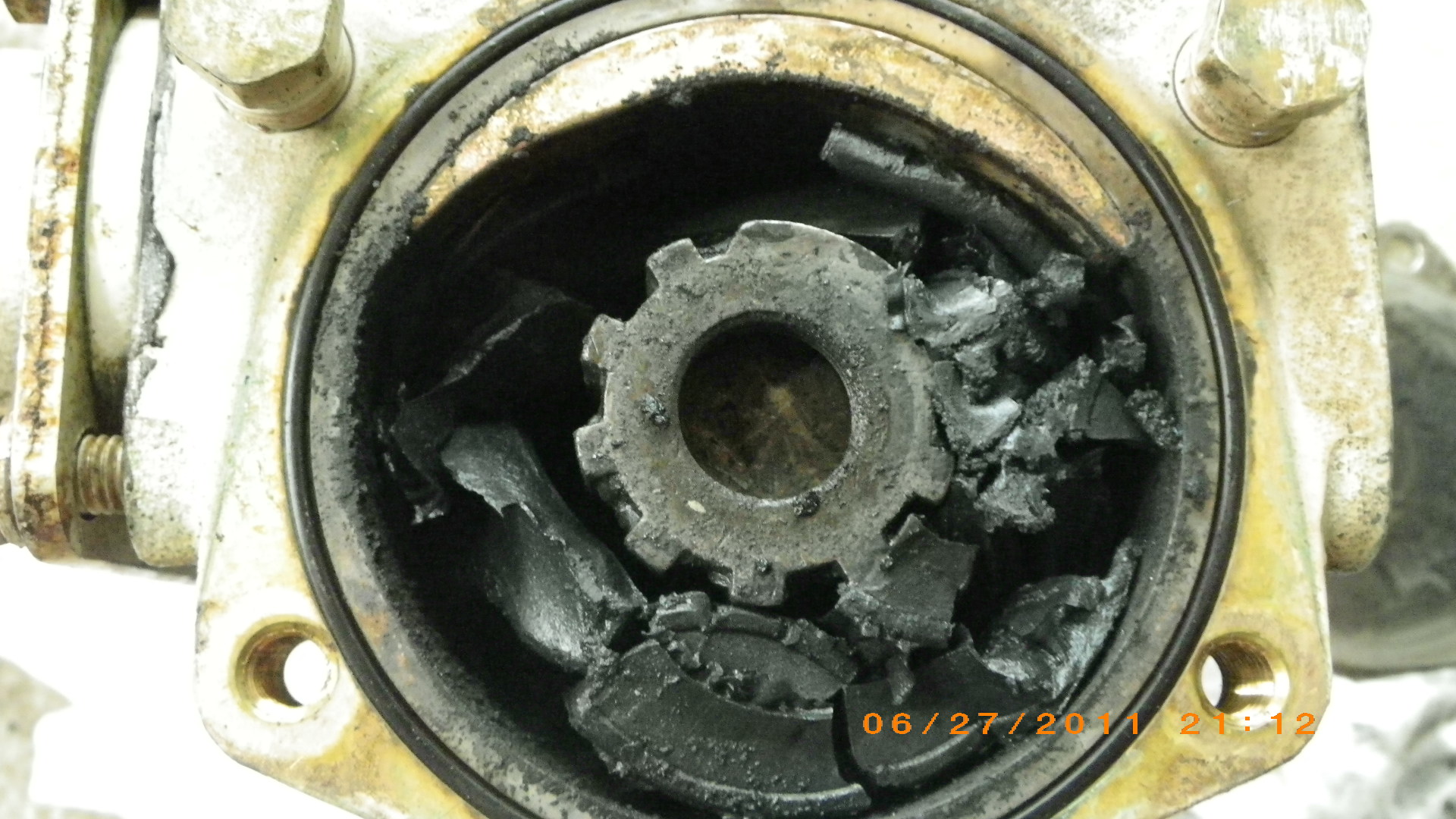
Our investigation found the fire was caused by a severely overheated engine exhaust system. The raw water pump impeller had failed, and was the root cause of the engine and exhaust system overheat event. The exhaust blew against combustible material and ignited the fire.
The captain stated that he had not been watching the engine instruments, but had heard no audible engine alarm. The recently completed mechanical survey did not mention a problem with the audible alarm system, but further investigation revealed the mechanic had found the problem, but that finding did not make the report. The mechanic had provided his handwritten notes to the report writer, but the inoperative engine alarm note was written the report on the back of his field notes and the report writer missed this note.
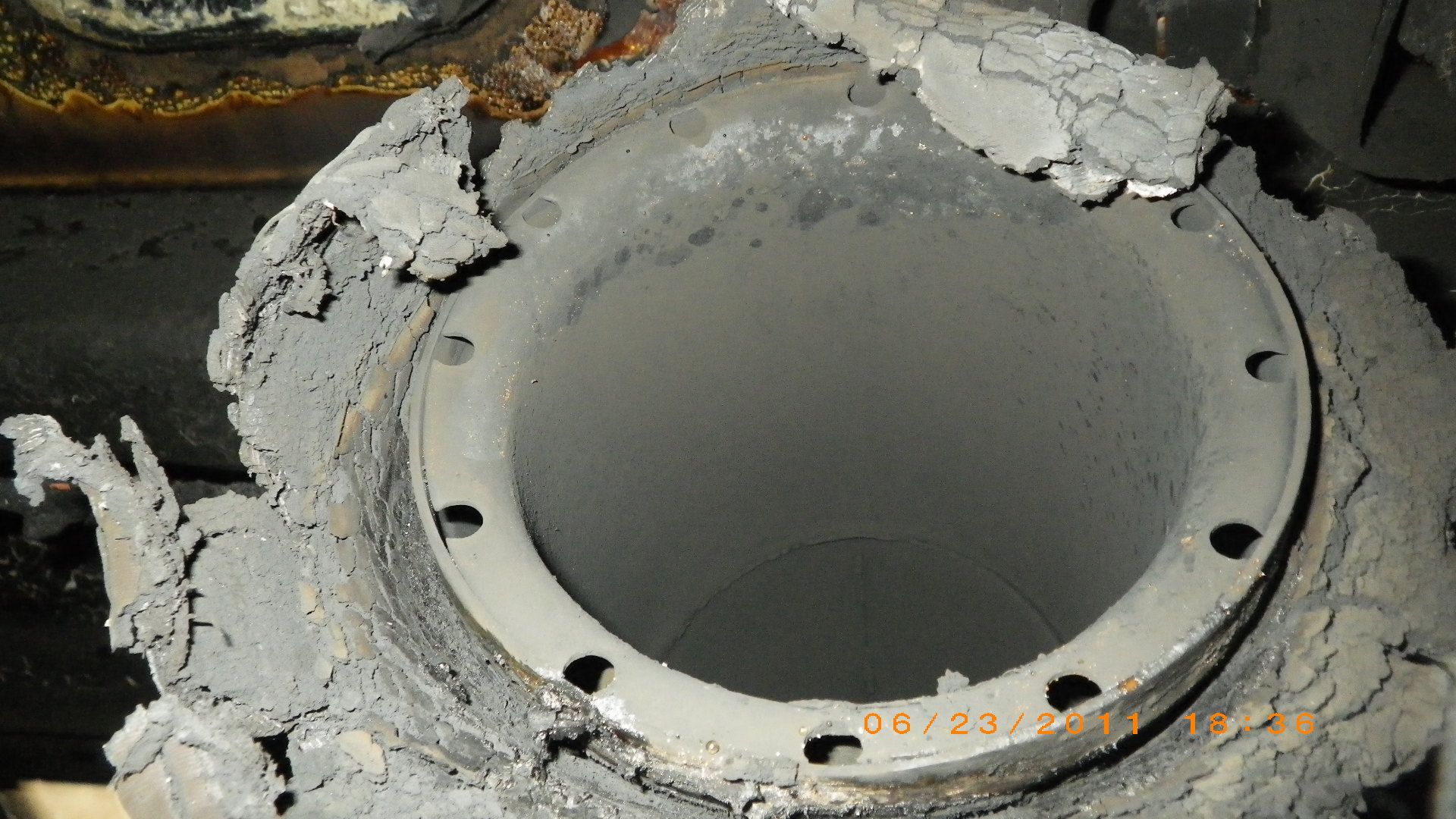
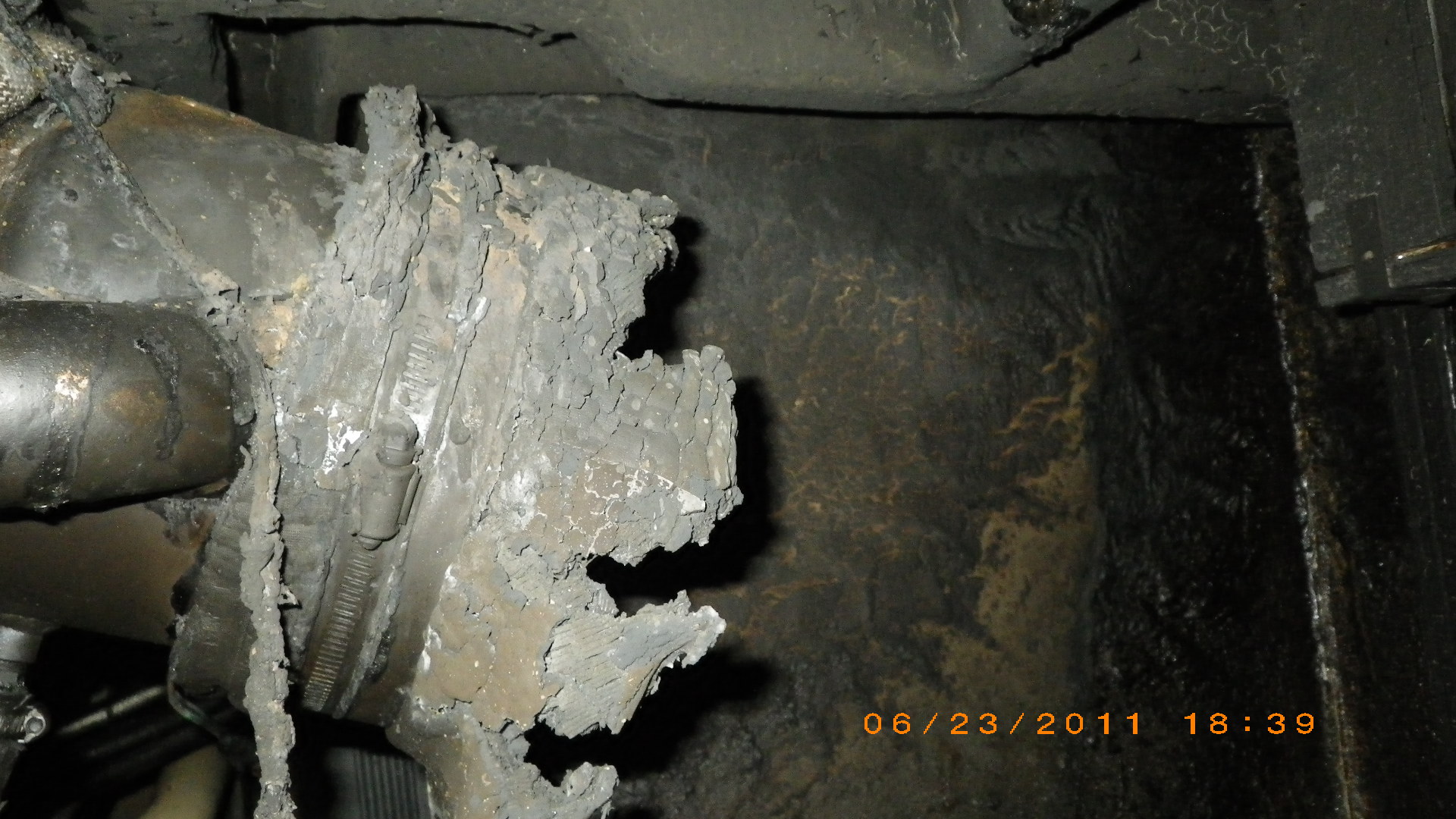
The overheating scenario is not uncommon. It takes about fifteen minutes for a boat engine to severely overheat, in a normal usage situation. Had the audible alarm alerted the captain or the owner to the engine overheating condition, the engine would have been turned off prior to catastrophic failure and prior to the fire. Engines overheat all the time with very little consequential damage.
This story had a semi-happy ending. Nobody was hurt, we got a job, the insurance company paid a total loss and another boat was purchased. The boat broker sold two boats in a short period of time and was extremely happy. We assume the boat owner went on to pursue her dream of boating and lived happily ever after.
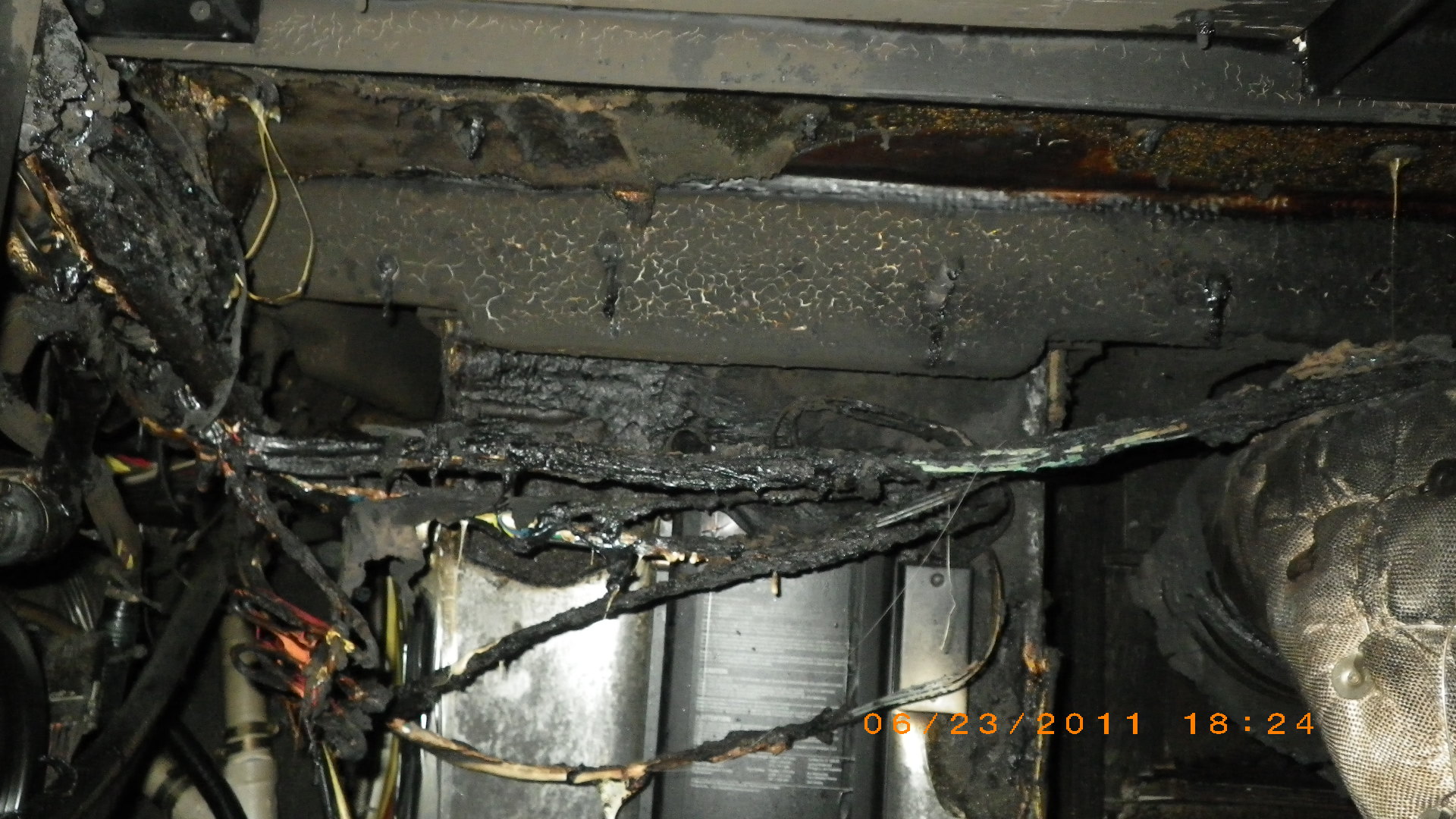
The lesson; audible engine alarms are critically important. Automatic fire extinguishing systems save lives. Boat fires are bad for you, bad for insurance companies but good for boat brokers and good for our business :>)
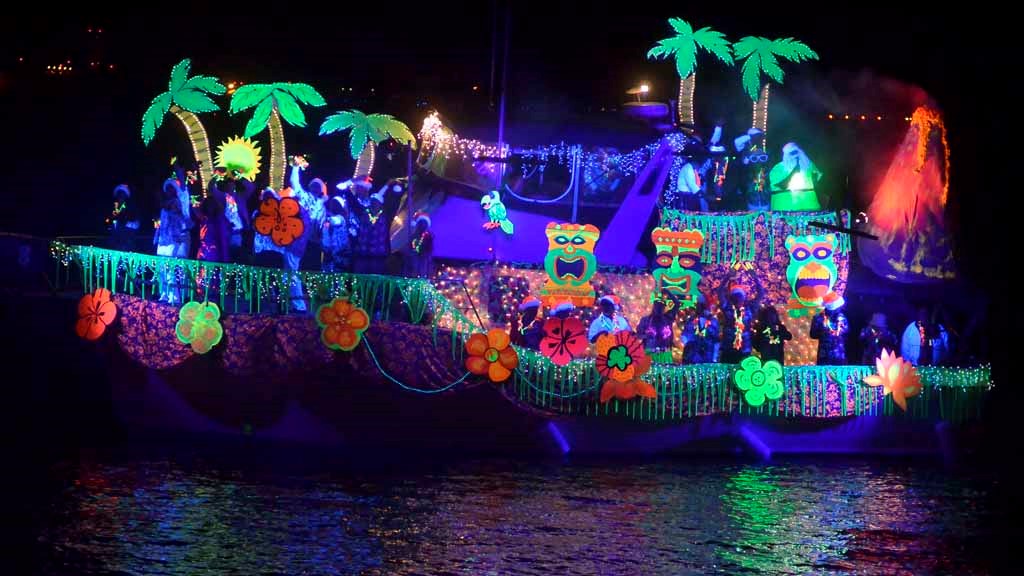
Last night I found motivation for a new article. I enjoyed the spectacular southern California sunset on my way to watch the San Diego Parade of lights on a motor vessel. I always enjoy the view of the San Diego skyline as the sun goes down and the lights come up. The view from the Shelter Island and Harbor Island areas always makes me grateful for where I live.
The parade of lights is an interesting event, allowing boaters to show creativity and holiday spirit. The subject for this year’s parade was “Arrrgh! A Pirate’s Christmas”. There will be a second parade December 17, 2017 starting at 5:00 p.m. at Shelter Island and ending at the Ferry Landing on Coronado around 7:00 p.m.
The bay was full of spectator boats and we took a lap around the bay after the last participant in the parade of lights passed us. That’s when the motivation for this article came.
I saw dozens of boats with improper navigational lights displayed. Some were missing a light, some displayed their anchor lights along with their running lights, but several had no lights on whatsoever.
I suppose it’s a matter of numbers, a certain percentage of boaters will fail to illuminate their lights, but the percentage seemed extra ordinarily high last night.
Many commercial vessels are now using LED lights which are illuminated whenever the vessel is operating, day or night. The electrical draw is negligible compared to the certainty of displaying the proper lights and additional safety. Remember lights need to be displayed in times of limited visibility, sun down, fog, or smoke.
I thought about driving a car without lights. The environment reminds you because you cannot see the road. Other cars can flash their lights as a reminder. But navigational lights are not head lights. And another boat blinking at you is unlikely to cause you to think about your own lights. I certainly have been guilty of forgetting to turn on my lights.
So I wrote this short reminder to you and to me. When I see another boat with their lights on, I will check my lights, make sure they are properly functional and the proper lights are illuminated.
Remember if your operating your vessel and you see any lights, on the shore, on a buoy or on other boats, check and make sure your lights are functional and illuminated. See the lights, check the lights.
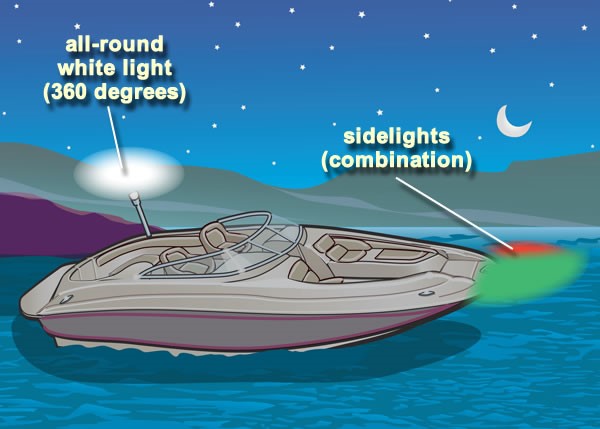
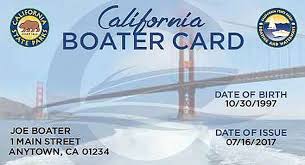
On January 1, 2018 a law requiring California boaters to have a valid California Vessel Operator Card (CVOC) takes effect. Initially only boaters 20 years old and younger will need the card. Each year the age limit is graduated by five years and every boater will need a card by January 1, 2025.
There are eight categories of exempted boaters, including operators of rental vessels, operators from other states and other countries, boaters who hold a Coast Guard operator’s license or boaters who hold a commercial fishing license.
Currently, California Harbors and Navigation Code Section 658.5, states that nobody under 16 years of age may operate a boat with a motor of more than 15 horsepower, except for a sailboat that does not exceed 30 feet in length or a dinghy used directly between a moored boat and the shore (or between two moored boats). The law allows children 12-15 years of age to operate boats with a motor of more than 15 horsepower or sailboats over 30 feet if supervised on board by an adult at least 18 years of age.
There are several companies offering online education for the CVOC. The law mandates that the education must be approved by the National Association of State Boating Law Administrators (NASBLA (not NAMBLA:>)) and by the California Department of Boating and Waterways.
If an approved course was taken after January 2015 you can use copy of that course certificate and submit it online at http://californiaboatercard.com/applynow/. Temporary cards will be issued immediately (for both courses previously taken and newly taken course) and actual cards will be issued starting mid-January, 2018.
The online courses cost approximately $25 – $30, with some sites offering group discounts.
The first infraction of the law is subject to a fine of not more than $100.00.
I have always supported volunteers who educate boaters, such as the Coast Guard Auxiliary and Power Squadrons. I believe the individuals who voluntarily attend these classes are more likely to succeed in becoming safe boaters, because they want to become safe boaters. The mandatory boating education courses appear to be much like the safe driving courses that are a mandated option when one receives a speeding ticket. It is doubtful that one stops speeding after taking such a course, though we often slow down as we gain wisdom through experience and age.
There are statistics that say states with mandatory education have fewer boating accidents and fatalities, and the low percentage of those involved in the accidents and fatalities that have a boater’s card also support the concept of boater’s education. This process seems to be a minor imposition on boaters, likely very easy for experienced boaters and hopefully a worth benefit to new boaters and the boating community.
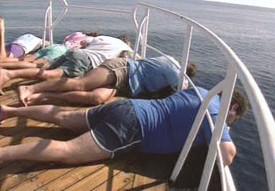
When the eyes perceive a different movement than the inner ear experiences the result can be sea sickness for a boater. While this is the common belief, the actual cause of sea sickness is not agreed upon by the medical community. Approximately 30% of the population is relatively immune to sea sickness while another 30% gets very little relief from common medications.
The research supports my personal experiences with sea sickness. While I have been sea sick, and understand the feeling, it is rare for me but three of our family of five are prone to it. Research suggests anxiety about sea sickness contributes to its frequency and rest and hydration help prevent it.
Eating lightly, including snacks such as ginger snaps and pretzels is preferred to not eating or to eating greasy or acidic foods. Wind across your face and staring at the horizon are proven to reduce discomfort and avoid others who are sick. Driving the vessel (and driving the car) is also helpful. Your senses tend to agree when you are in control of the boat and watching the seas. The back of smaller boats and amidships near the water line in ships generally has less movement. Staring at the horizon on deck is preferred to confusing your senses down below. An easy rule to remember is back of the boat and front of the plane.
If one of the crew is sick, exercise caution if they are heaving over the side of the boat. Sea sickness is bad but a person overboard, particularly in heavy weather, is worse.
There are both homeopathic and “western medical” means for prevention and acute treatment of motion sickness. Homeopathic treatments generally have little to no side effects. Research indicates that some treatments are extremely effective on some people, thus trying various treatments is suggested. Unfortunately there are so many variables and unknowns in motion sickness, your personal research may take a long period of time and accurate record keeping to be effective.
A common homeopathic treatment is acupressure or electro acupuncture on the T6 pressure point. This is the pressure point approximately two fingers up the forearm from the wrist. There are a multitude of wristbands and bracelets which apply pressure to this pressure point. There are electric wrist bands with variable intensity settings and both of these methods are effective on some.
There is an extensive amount of medication available for sea sickness. Primarily anticholinergics and antihistamines are used. Scopolamine is usually applied as a patch behind the ear and it works as both prevention and treatment for sea sickness. Antihistamines such as Dramamine and Bonine are most effective as preventative medicines and need to be ingested one to two hours prior to departure. The common side effects include drowsiness and dry mouth.
A non FDA approved medicine Cinnarizine (brand name Sturgeon) is mentioned in several studies and may be the most effective antihistamine with fewest side effects.
NASA and the U.S. Navy use conditioning and de-sensitization to reduce motion sickness in astronauts and pilots. So get out there, boat more often, and stop worrying about getting sick.

Here are a two of many helpful sites:
https://www.wholesomeone.com/condition/motion-sickness-natural-treatments
http://www.webmd.com/drugs/condition-13723-Prevention+of+Motion+
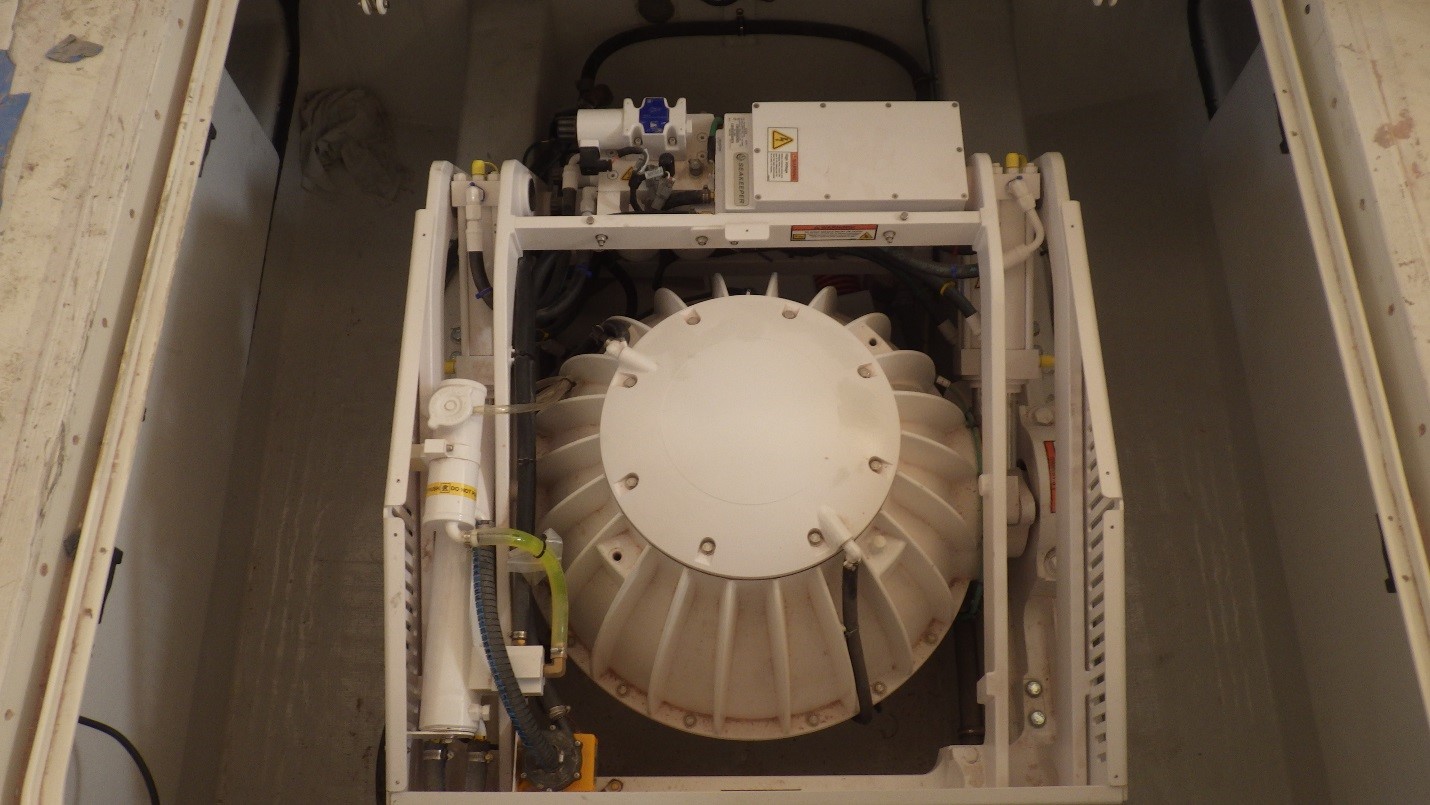
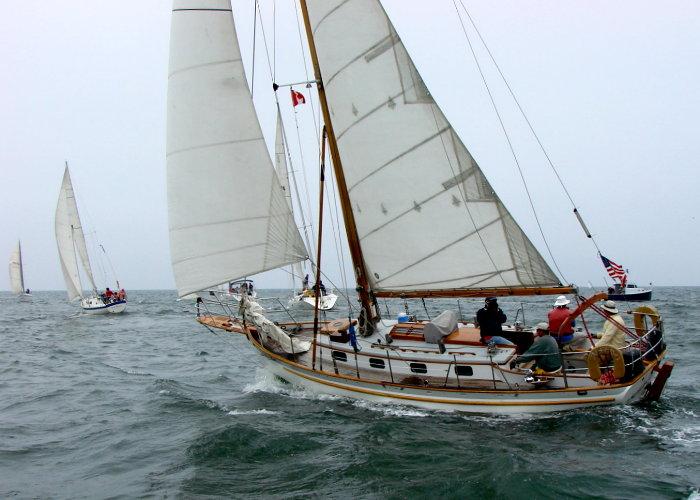
 |




The photographs of the shore power cord and damage to the dock and boat were found as I arrived for a condition and valuation inspection for an owner that lived out of state. The inspection was requested by his insurance company, who apparently dodged a bullet.
As boating season winds down, our visits to our boats dwindle. Many of us live remotely from our vessels and over time we grow comfortable in their self preservation. Shore power systems are commonly found defective. Dock box circuit breakers are designed to prevent problems like this, but are notoriously unreliable.
By their nature shore cord connections are subject to weather, movement and wear. All of which increase resistance and thus temperature of the conductors.
Approximately one out of every five boats we inspect has some problem with the shore power system.
The most common problem is heat damage at the shore power cord or vessel connectors. No amount of heat damage to these components should be disregarded. A small amount of visible heat damage is often an indication of much more significant damage which is not visible. Think visible part of iceberg versus what is below the water.
Because of our involvement with damage claims, we investigate many vessel fires and work alongside origin and cause experts. Their conclusions are often that the fire was electrical in nature and initiated near the shore power inlet. While some of these fires have been localized to the vessel itself and even to just the shore power inlet area, some result in entire marinas going up in flames.
A few simple practical pointers.
Make sure all designed components for the connectors are present and functional. Shore power cords should have a means to secure the cord to the inlet and protect the conductors from weather. The shore power cord should have strain relief where necessary. If your cord dangles five feet from the inlet to the dock, strain relief should be used to eliminate the strain between the cord and the inlet.
A shore power cord should not look like these.
Always make and break dead connections. The circuit breaker at the dock should be turned off prior to connecting or disconnecting the shore power cord from the vessel. The circuit breaker should be turned back on only after the shore power cord connection has been made at your boat. This prevents arcing damage which will contribute to problems at the connector.
I am fond of a product called “Smart Plug”. The plug requires no twisting and has features which reduce several of the problems that we encounter regularly, but it is more expensive.
Besides fires, many problems are caused by shore power malfunctions. Regularly checking shore power connections is an excellent way to avoid these problems. Your boating neighbors can help.
Take a moment, like that time in church where you shake the hands of those around you, and meet your neighbors. In addition to challenging strangers you see aboard each others’ vessels, develop a mutual plan for checking shore power cords and exchange contact information, the boat you save could be yours.
Most Southern California boaters, with the exception of a few alpine lake stored boats, don’t have to worry about snow accumulation or the water freezing around the boat. We have our own set of challenges brought upon by lower temperatures, rain and infrequent visits. We addressed shore power cords in our last article, here we address other issues.
As the temperature drops, heaters come out of the lockers. We find portable electric heaters on virtually every boat we inspect. Some heaters are better suited for use aboard a vessel. Some heaters will cut their power if they tip over, some have a wide base and are less likely to tip over, but few are designed to be left unattended aboard a boat. Above is a melted circuit breaker for a built in cabin heater.
Bring aboard only the most suitable type of heater, remember the boat may be used by somebody less familiar with boats than you are. Gas heaters, wood stoves and other improvised heating devices have also been known to cause problems.
The use of heaters and decorative lights increases the amperage in the AC electrical system and this increase can cause problems to develop or become apparent.
During a recent pre-purchase survey of a 50 meter power vessel, one of the crew was surprised to learn that several of the air conditioners also functioned as heaters. The older vessel had a combination of heat pump style units and household type units which only functioned in the cool mode. They were surprised to learn that the heat pump units functioned in both the heat and cool modes. This type of heater is much safer than a portable heater.
Boat fact: reverse cycle / heat pump type air conditioning units’ function is most effectively tested in the heat mode in Southern California. Heat is distinct versus blown air which can feel cool.
Winter is our rainy season, in addition to checking deck drains, hatch drains and the associated hoses and valves, this is a good time to check bilge pumps. If you don’t know how to check the automatic function of your bilge pump, learn. You-tube has everything. Know that your automatic bilge pump will only work as long as its battery is charged.
De-humidifiers are usually much safer than space heaters. Many boat air conditioners have a de-humidifier function as well. While de-humidifiers can prevent mould and mildew, we suggest inspecting the boat after the first rain for any leaks. Your boat will eventually leak, the quicker the leak is found and fixed the better chance you have to reduce resulting damage. Leaks onto electrical components can lead to problems. A common finding is water accumulated in dome lights. It is not uncommon to find water leaking on to or near electrical distribution panels, as they are often outboard near the hull to deck joint and below deck hardware.
Finally, if you are going to keep frozen food aboard, especially seafood or bait, be aware of potential problems from a loss of shore power. Standard galley refrigerators can leak and significant damage has occurred when frozen fish thaw. Consider a deep freezer for your fish or bait, their design will capture this disgusting soup and limit the damage.
As a marine surveyor assisting insurance companies with claims our primary duties are to determine cause of loss, scope of damage and review repair costs. The type of boat claims most surveyors receive are varied, from submersion damage to lightning strikes to mechanical failures. No one is an expert in all experts, we all cannot be electrical and mechanical engineers, metallurgists, experts in rules of the road, lamination experts or coatings experts. We simply need be proficient and know our limits.
The types of engines and drive systems that experience failures are varied and a good example of modern marine surveying. Further, different insurance carriers require different levels of cause or determination. Some carriers merely need to know if the cause was mechanical (from within the engine) or external, plastic bag, submerged object, bad fuel etc…).
A recent claim for a failed diesel engine began with the discovery of plastic components in a sea strainer. A tear down of the engine revealed a single cylinder failure, not caused by the plastic. Interestingly the insured thought the claim may not be covered if it wasn’t caused by the plastic but this mechanical failure was not excluded by the policy. Some insurance companies require much more specific cause or determination. This can be to allow proper cover decisions or to preserve subrogation rights. In another recent claim an inboard diesel engine had been rebuilt and had been rebuilt approximately one month prior to the loss. The warranty was for six months. Our inspection resulted in the determination of a mechanical failure from a component within the engine, however this carrier required a more specific determination. Again, the mechanical nature of the failure was a key factor.
There is no shame in not being able to more specific in a cause or determination such as this. In this case a forensic engineer was hired to attempt find “the smoking gun”. In modern insurance claims it is important to remember the basics, develop the history, any recent repairs and the precise event details from the operator. Be sure to separate opinions developed after the loss from consultations with varies from the facts of the actual events. Be aware that our failure analysis skills often evolve past those of the trained mechanic, as their job is not the same as ours. A skilled and ethical mechanic is one of our best tools cross checking opinions with other mechanics is also an option. With modern machines don’t forget the computers. Recording error messages and understanding their significance can be vital. In a recent failure claim we were provided “compression readings” as proof of the condition of an engine prior to loss. Further analysis revealed that these “compression” test results were a computer analysis versus an actual pressure gauge inserted in the injector tube. So obtain the error codes but also understand their significance.
“Pokemon, STOP!” is the plea from a San Diego marina. A Pokemon stop is where players of this augmented reality game go to collect Pokemon. As a parent of 16, 18 and 20 year olds, I became aware of the game several months ago, but have not played the game. I have observed the capture of a Pokemon in my living room.
I did little research for this article and like boaters scoffing at the depictions of boating in movies and television shows, Pokemon players can poke fun and poke holes at the facts in this article. Who cares, warning to techies, this is not Mr. Robot.
While driving to a boat in Coronado I noticed a gathering of mostly young people in the grassy median on Orange Avenue. My son / apprentice informed me that this was an intersection of Pokemon stops; the gang of players was oblivious to the passing cars.
When I first noted the sign (above) at the marina I thought they were joking and were actually hosting a Pokemon event. How wrong I was. Turns out the players were a major nuisance.
The Pokemon stop that quickly caused overcrowding issues at the marina is apparently the result of an adjacent park. Niantic Inc. designed this game to be played while walking and thus many of the stops (and gyms) are located at public parks. Most agree this is a positive part of Pokemon Go. Young people actually leaving their dark computer dens and getting outside.
However, sometimes all the players see while outside, are the Pokemon. Just before sunset, at a beachside bluff, two young people arrived, quickly caught their Pokemon and departed just before the sun made a magnificent departure. The youngsters had succeeded in getting out of their digital den, but missed a colorful exhibition of nature and a chance at a green flash.
There are stories of Pokemon players walking off cliffs, perhaps a Darwinian thinning of the herd. Players should be conscious of the inconveniences and impositions caused by their play. They should not trespass, block gates and sidewalks or be unaware of other problems they cause as individuals or groups.
And boaters should be happy these young people are outside, walking around and socializing. Perhaps we should take a cue from the Pokemon Go players and leave the house, go to our boats, untie the lines and enjoy the great outdoors. In the words of a famous Southern Californian, “Why can’t we all just get along?” Pokemon Go is a fad which is already fading. The troubles at the marina have abated; the players and boaters are learning to co-exist.
Located at kilometer marked 73 (km 73) is the only port between the U.S. Border and Ensenada, Mexico. But don’t plan on using this as a port of refuge unless you are driving a personal water craft.
The marina was built approximately fifteen years ago. Problems with the silting of the channel, intermittent dredging and modification of the jetty were mentioned during a handful of marine surveying jobs we performed there in its early years.
In the last several years I have seen a sandbar across the marina entrance and I stopped and spoke with general manager in July 2016. Mr. Paul Hernandez, the general manager of Marina Puerto Salina, stated that the current shallow water channel problem has existed for four years. He stated that the water depth reaches 3’ on low tide and entry and exit from the marina is still possible at high tide. He stated that the owner of the marina is currently focused on a project in Cabo San Lucas and thus the marina has been neglected and the condominiums remain unfinished.
Researching the marina I noticed an article in The Log from May 2013, discussing the shallow water entrance.
During my visit I spoke with an unknown individual aboard a vessel named “Warlock”. He stated that the vessel has been in the marina for nine years and stuck for the last six. His vessel is a 60’ power boat which like draws 5’.
There are thirty to forty boats in the Marina and we have noticed very little activity. On a July 13, 2016 visit there were a few locals at a convenience store there was no activity on a launch ramp or in the marina except for the gentleman aboard “Warlock” varnishing a cap rail.
On August 28, we did notice a jet ski operating in the marina channel. I have recently been told that there are tax benefits in Mexico realized for unfinished properties. I was told that sometimes properties are left partially unfinished, i.e. rebar exposed from raw cinder blocks, because the tax benefit is eliminated once the property is finished.
While I have no idea if this tax benefit has any bearing on the state of Puerto Salina, it is clear that the condominiums remain unfinished and the harbor entrance is un-dredged and too hazardous to provide a port of refuge or planned stopping point between San Diego and Ensenada.
Other bits of Baja California Norte News: I surveyed a boat at Puerto Salsa, just north of Ensenada in the last few months. As an active marine surveyor in this area since 1993, it is rare that I visit an established boat yard for the first time. This commercial port hauled a 120’ passenger vessel that had its engines and generators replaced during the haul out.
The most well known superstition of course is the re-naming of the boat. The origins are apparently Greek (Poseidon), continuing through the Romans (Neptune) and at least peripherally influencing the Norse (Ran, Aegir, Njord, Odin and Hagar). Boaters, fisherman, sailors, etc.… are superstitious folk.
The “bad luck” is brought upon by the God of the Sea who maintains a ledger of all boat names. Thus the first component to disable the bad luck of a new boat name is the de-naming ceremony. This ceremony causes the God to forget the name and of course requires alcohol.
All of these ceremonies require quality champagne or wine. To properly de-name the vessel, first pour a portion of the beverage into the ocean as an offering to the God and then pour some into your mouth(s). The alcohol helps the God forget.
Next gather all items emblazoned with the previous name, burn them and scatter the ashes into the sea. “White out” the “Previous Vessel Names” on your Coast Guard documentation, as you might need it later; otherwise make sure all vestiges of the old name are completely eliminated.
The re-naming ceremony begins with appeasing the Gods with more liquor and a request that they accept the new name. Following this second offering to the Gods, a glass of the quality champagne or wine is enjoyed by the captain and the first mate, in the name of good luck. Don’t bring aboard anything with the new name until the first ceremony is complete, or you’ll have to do a lot more drinking to do.
The last required ceremony is the appeasement of the four winds. This ceremony includes (yep, you saw it coming) pouring four equal amounts of the chosen beverage and tossing them in each of the primary compass directions. The remainder of the beverage is to be consumed by those involved in the ceremonies.
During my training I was taught that nudity was involved in this ceremony, however, I found no such reference in my exhaustive validation research. I did come across a reference to naked women. It is bad luck to have women aboard, because they distract sailors from their duties, but naked women are good luck because they calm the seas. Thus topless figurines of women adorn the bows of so many sailing ships.
The takeaway is that quality champagne or wine help solve boating problems. If you and/or your first mate are recovering from alcoholism, we support you. Please contact us and someone from our office will be happy to perform the ceremonies on your behalf.
p.s. we like women on our boats, with or without clothes